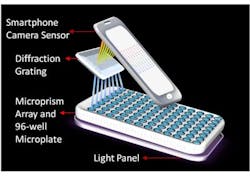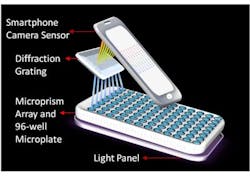Smartphone-based spectrometer detects cancer at the point of care
A team of researchers at Washington State University (Pullman, WA) has developed a low-cost, smartphone-based spectrometer that can analyze several samples at once to detect a cancer biomarker, producing lab-quality results at the point of care.
Related: Smartphone-based ELISA reader performs medical diagnostics at the point of care
The research team, led by Lei Li, assistant professor in the School of Mechanical and Materials Engineering, created an eight-channel smartphone spectrometer that can detect human interleukin-6 (IL-6), a known biomarker for lung, prostate, liver, breast, and epithelial cancers. A spectrometer analyzes the amount and type of chemicals in a sample by measuring the light spectrum.
Although smartphone spectrometers exist, they only monitor or measure a single sample at a time, making them inefficient for real-world applications. Li's multichannel spectrometer can measure up to eight different samples at once using a common test called enzyme-linked immunosorbent assay (ELISA), which identifies antibodies and color change as disease markers.
Although Li's group has only used the smartphone spectrometer with standard lab-controlled samples, their device has been up to 99% accurate. The researchers are now applying their portable spectrometer in real-world situations, and Li has filed a provisional patent for the work.
"The spectrometer would be especially useful in clinics and hospitals that have a large number of samples without onsite labs, or for doctors who practice abroad or in remote areas," Li says.
Full details of the work appear in the journal Biosensors and Bioelectronics; for more information, please visit http://dx.doi.org/10.1016/j.bios.2016.09.021.

